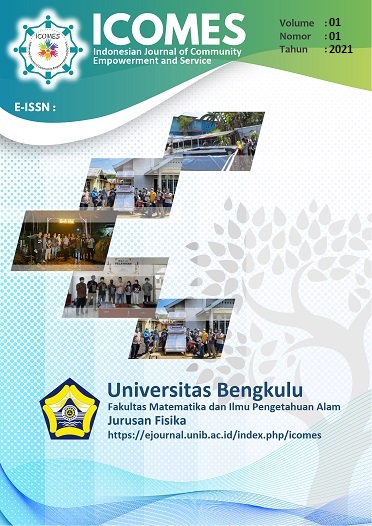Main Article Content
Abstract
Since the emergence of Covid-19 in Indonesia in early 2020, it has spread throughout Indonesia, including rural areas. The Serut District, which is a border area, namely the Klaten district with Gunung Kidul, cannot be separated from the spread of Covid-19. The condition of the people of Serut Village, which is a genuine rural community, causes a lack of understanding of the dangers of the virus. The confusion of news in the mass media and social media has made the understanding of Covid-19 blurry. One of them is a non-invasive oxygen saturation detection system technology using an oximeter to monitor blood health conditions. This is very important, especially for patients who have confirmed Covid-19 and are self-isolating at home. In this service, the implementing team collaborates with the Serut Village government and the ranks of the Covid-19 task force to mitigate Covid-19 in the Serut Village area. The programs that will be implemented include providing materials and demonstrations for detecting oxygen saturation in the blood using an oximeter to the Covid-19 task force. The provision of materials and demonstrations will be continued with data sampling and analysis to the people of Serut Village. This program aims to introduce the system of measuring oxygen saturation in the blood and how to measure it independently. This is very important considering that oxygen saturation in the blood is one of the parameters in Covid-19 patients.
Keywords: Oximeter; Blood Oxygen Saturation ;Satgas Covid-19; Kalurahan Serut
Article Details
The author has the copyright and entitles the journal to the first publication with works that are licensed simultaneously under the Creative Commons Attribution CC BY License which allows others to share their work with the recognition of the authorship of the work and initial publications in this journal.
The author can make separate additional contract agreements for the non-exclusive distribution of published journal versions of the work (for example, posting them to the institutional repository or publishing them in a book), with recognition of the initial publication in this journal.
Authors are permitted and encouraged to post their work online (e.g., in institutional repositories or on their websites) before and during the delivery process because it can lead to productive exchanges, as well as quotes that are earlier and larger than published works
References
- DeMeulenaere, S. (2007) ‘Pulse Oximetry: Uses and Limitations’, Journal for Nurse Practitioners. doi: 10.1016/j.nurpra.2007.02.021.
- Lopez, S. (2012) Pulse Oximeter Fundamentals and Design, AN4327. doi: 10.1521/ijgp.2008.58.1.55.
- Njoum, H. and Kyriacou, P. A. (2013) ‘Investigation of finger reflectance photoplethysmography in volunteers undergoing a local sympathetic stimulation’, Journal of Physics: Conference Series, 450(1). doi: 10.1088/1742-6596/450/1/012012.
- Salamah, U. (2016) ‘Rancang Bangun Pulse Oximetry Menggunakan Arduino Sebagai Deteksi Kejenuhan Oksigen Dalam Darah’, Jurnal Penelitian Fisika dan Aplikasinya (JPFA).
- Sinex, J. E. (1999) ‘Pulse oximetry: Principles and limitations’, American Journal of Emergency Medicine. doi: 10.1016/S0735-6757(99)90019-0.
- Smith Medical PM (2007) ‘How can SpO 2 readings differ from manufacturer to manufacturer ?’, Manual Pulse Oximetry, pp. 2–5.
- Susilo, A. et al. (2020) ‘Coronavirus Disease 2019: Tinjauan Literatur Terkini’, Jurnal Penyakit Dalam Indonesia, 7(1), p. 45. doi: 10.7454/jpdi.v7i1.415.
- Syafrida, S. and Hartati, R. (2020) ‘Bersama Melawan Virus Covid 19 di Indonesia’, SALAM: Jurnal Sosial dan Budaya Syar-i, 7(6), pp. 495–508. doi: 10.15408/sjsbs.v7i6.15325.
References
DeMeulenaere, S. (2007) ‘Pulse Oximetry: Uses and Limitations’, Journal for Nurse Practitioners. doi: 10.1016/j.nurpra.2007.02.021.
Lopez, S. (2012) Pulse Oximeter Fundamentals and Design, AN4327. doi: 10.1521/ijgp.2008.58.1.55.
Njoum, H. and Kyriacou, P. A. (2013) ‘Investigation of finger reflectance photoplethysmography in volunteers undergoing a local sympathetic stimulation’, Journal of Physics: Conference Series, 450(1). doi: 10.1088/1742-6596/450/1/012012.
Salamah, U. (2016) ‘Rancang Bangun Pulse Oximetry Menggunakan Arduino Sebagai Deteksi Kejenuhan Oksigen Dalam Darah’, Jurnal Penelitian Fisika dan Aplikasinya (JPFA).
Sinex, J. E. (1999) ‘Pulse oximetry: Principles and limitations’, American Journal of Emergency Medicine. doi: 10.1016/S0735-6757(99)90019-0.
Smith Medical PM (2007) ‘How can SpO 2 readings differ from manufacturer to manufacturer ?’, Manual Pulse Oximetry, pp. 2–5.
Susilo, A. et al. (2020) ‘Coronavirus Disease 2019: Tinjauan Literatur Terkini’, Jurnal Penyakit Dalam Indonesia, 7(1), p. 45. doi: 10.7454/jpdi.v7i1.415.
Syafrida, S. and Hartati, R. (2020) ‘Bersama Melawan Virus Covid 19 di Indonesia’, SALAM: Jurnal Sosial dan Budaya Syar-i, 7(6), pp. 495–508. doi: 10.15408/sjsbs.v7i6.15325.
